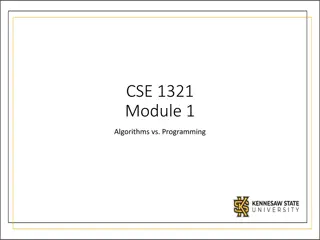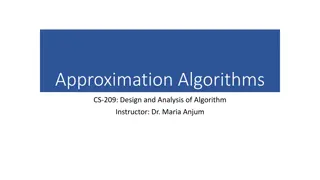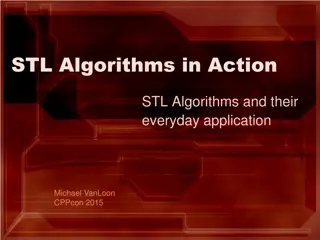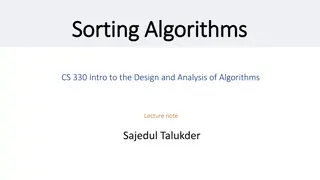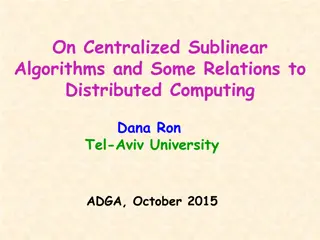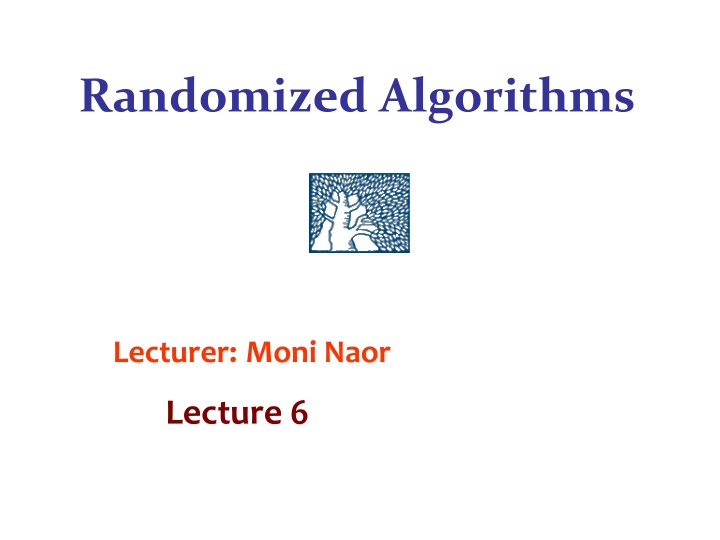
Memory Checking Model and Efficient Guessing Strategies in Randomized Algorithms
Explore the Memory Checking Model for secure data access and efficient guessing strategies in Randomized Algorithms. Discover how encoding techniques and memory utilization enhance performance in computational tasks.
Download Presentation

Please find below an Image/Link to download the presentation.
The content on the website is provided AS IS for your information and personal use only. It may not be sold, licensed, or shared on other websites without obtaining consent from the author. If you encounter any issues during the download, it is possible that the publisher has removed the file from their server.
You are allowed to download the files provided on this website for personal or commercial use, subject to the condition that they are used lawfully. All files are the property of their respective owners.
The content on the website is provided AS IS for your information and personal use only. It may not be sold, licensed, or shared on other websites without obtaining consent from the author.
E N D
Presentation Transcript
Randomized Algorithms Lecturer: Moni Naor Lecture 6
Recap and Today Recap Multiset equality Communication Complexity Streaming - Frequencies Today Streaming Proof by encoding
Memory Checking Model Secure zone CPU needs to make sure what it read is what it wrote Accesses addresses q1, q2 qi CPU Main memory Small private memory M[qi]
Guess the card Guessing the next card: Cards from a known playing deck with n You try to guess the next card, for n rounds No memory: expected number of correct guesses: 1 Perfect memory: expected number of correct guesses: ?? What if there are s bits of memory? Can get ?? Is this the best possible? Idea: remember the first s (in terms of face value) cards and ignore the rest No! Can do almost twice as better
Idea: Encoding the last cards Can know for certain the last card using log n bits: sum Can generalize to k last cards using O(k log n) bits: for instance, the polynomial from the set comparison protocol Track the value of the polynomial at k points Starting with the value of the points of the set S={1, 2, n} Can use this to get ?? for ? = ?/????
Idea: two methods are compatible! Of the s bits use s/2 for the first method and s/2 for the second. The last card with face value in {1, ..., s/2} is expected when there are 2n/s cards left. Best split? So for ? ? the two useful periods do not overlap! We get min{ ??? ,??/????} For s = ? we get almost as much as for s=n
Encoding the last k cards In our case: {1,2,...,n} Use the setting of the multi-set comparison Treat the set A as defining a polynomial (? ?) ??? = ? ? over a finite field of size is larger than the universe from which the elements of A are chosen+|A| say a prime Q > |U|. Evaluate ??? at k points, n+1, n+2, n+k. As the card y go by divide the value of point n+i by (y-n-i).
Computing on streams How many elements? How many different elements? What is the most frequent element Who are the heavy hitters? Frequency Moments For element j U, let ?? {0,1,2,...,m} be the number of times that j occurs in the stream. For integer k: the kth frequency moment ?. ??:= ? ???
Frequency Moments ? ??:= ?? ? ? The bigger k is, the more ??is dominated by the largest frequencies. Define ? = max ? ???as the largest frequency of any element of U.
Estimating ?? Strategy Find a randomized unbiased estimator of ??, which can be computed in one pass. Want a result that is correct on average. Aggregate many independent copies of the estimator, computed in parallel to get an estimate that is accurate with high probability How to aggregate?
Estimating ?? Should be independent of the stream. We will see that 4-wise ind. Is enough Let h:U { 1} be a ``random function that associates each universe element with a random sign. The function h is chosen at the beginning and stored Initialize Z=0 Every time a data stream element j U appears, add h(j) to Z. Increment Z if h(j) = +1 and decrement Z if h(j) = 1. Return the estimate ? = ?2.
Good Estimator Claim: For every data stream ? [X] =?? Linearity of expectations Ind. of the values of h Pairwise is enough!
Are Great Expectations Good Enough? Example: count the number of satisfying assignments of a given formula Better: use variance Recall: Markov s inequality (non-negative) Pr[? > ? ] ?[?]/? Chebychev s inequality Pr[|? ?[?]| ? ] ???[?]/?2 Chernoff-Hoeffding Inequality Need complete independence ??? ? = ?[(? ? ? 2] ? are Claim: If the ?? pairwise independent: then same variance
Good Variance Claim: For every data stream ??? [X] =2?? Why is this good enough? Let Y=1 ? ?=1 ?? The variance of t independent trials goes down as 1/t 4-wise independence sufficient ? 2 Claim: For every data stream, with ? = ? 2, 1 2 ?[? (1 ) ??] 1 ?. Pr
k-wise independence Approach: use k-wise independence for smallest k possible Definition: A family H of hash functions : ? ? is k-wise independent if for any distinct x1,...,xk U and for any y1,...,yk [0,...,m-1]: Pr [h(x1)=y1^ h(x2)=y2^ ... ^ h(xk)=yk] = 1/|U|k h H Exactly as what happens with a truly independent function
Constructing 3-wise independence Domain U be of size 2?range is just 1 bit Each element ? ? corresponds to a binary vector of length m+1 ?1,?2, ,??,1 The function ?is defined by a (random) vector R= ?1,?2, ,??,??+1 ?(x) = x,R = ?=1 Claim: every 3 vectors x,y and z are linearly ind. Claim: linear independent implies stochastic independence then the resulting product is k-wise independent Family size is 2?+1 ?+1????mod 2 True for any k: if any k vectors are linearly ind,
Homework: Guess the card Half of the cards are red half black Cards turned one by one At any point can stop and guess that the next card is red What is the probability of success of best algorithm? Note: look at exercise 2.32 in the book The Secretary problem These are not the same problems

